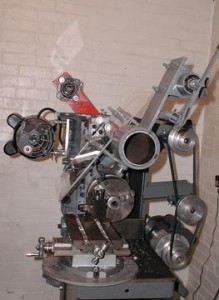Sunday, December 19, 2010
Monday, December 13, 2010
Procedural Objects
It won't be long before someone gets a full color 3D print of their minecraft world.
Sunday, December 12, 2010
Fab@home, RepRap or MakerBot?
Fab@Home has a dremel attachment tool and can do 3 axis CNC milling. So if you were considering getting a 3 axis CNC machine, get a fabathome instead. You can use our software for controlling and planning the prints, or you can use the Snap motors program listed on the JRKERR website to use G-Codes to do milling and interface with MasterCAM or other G-code based programs.
Fab@Home has a much larger build area than the makerbot or repraps and can use a wider array of toolheads. Repraps are cheaper in terms of BOM but take a lot more care to build, and take a lot longer to build. Not to mention to cost of getting your initial plastic parts made. If you want something that you can order and use in a day, your options are Fab@Home and Makerbot."
Wednesday, December 1, 2010
Open Source Machine

Sunday, November 14, 2010
Mr.doob Voxels
Sunday, October 17, 2010
Make the Most Difference
The work you do should be treated the same way. Your skills and time matter, and you shouldn't waste them. You should find the most important thing you can do, and do that.
This doesn't mean everyone has to do the same thing. Obviously everyones' skills are different, but it's also true that any given task can become saturated. No matter how important a task is, if enough people are working on it, your added individual effort might not do as much good as working on some less important, but understaffed project. It's great to be a Doctor, but it's possible for a society to have too many Doctors. On the other hand the skills you have (or could get) must have some field of application which is currently the least well served, relative to it's importance.
This is where you can make the most difference.
Thursday, September 9, 2010
Tuesday, September 7, 2010
Pushing towards easy open source robotics
Monday, September 6, 2010
RepRap sucks?
After many time building my RepStrap, printing parts for Mendel and finally build my Mendel, I asked on dev mailing list about "RepRap roadmap" -- seems there is no defined roadmap.
Because there is no roadmap, I can't know what will be RepRap in next 1, 3, 5 years. Will RepRap improve and be userfriendly, being useful for people? --- I don't think so, because none developers expressed that intention. It's clear not and objective and nor a priority.
This reminds me of the criticism Linux got when it still had really bad usability issues.
As user jbayless says:
"RepRap is difficult to build and tune, that's for sure, but it takes perseverance. I would have much more pride -- and faith -- in a printer that I'd built and helped to design, than in a closed-source competitor. But this approach is not for everybody. "
The core of a complex machine or piece of software will always be complicated and hard to configure. Once the ubergeeks get that core working, others can layer on interfaces that do the hard configuration automatically. If the core is open source.
Sunday, September 5, 2010
A Future Post on Future Posts
Tuesday, August 31, 2010
Elevator Pitch
developed, they will be able to make almost any device, and that will
change the world. Right now, not enough people know how to build them,
or use them, or even that they exist.
The Replicator Rabbit Project helps people by showing them how to use
incredibly powerful tools that we have today.
Saturday, August 14, 2010
Download K3D. (Or try your Linux package manager, it's probably in there.)
I followed this Demo, and though there are a few minor differences with the version I have, I modeled a coffee cup just like this in under 5 minutes.
